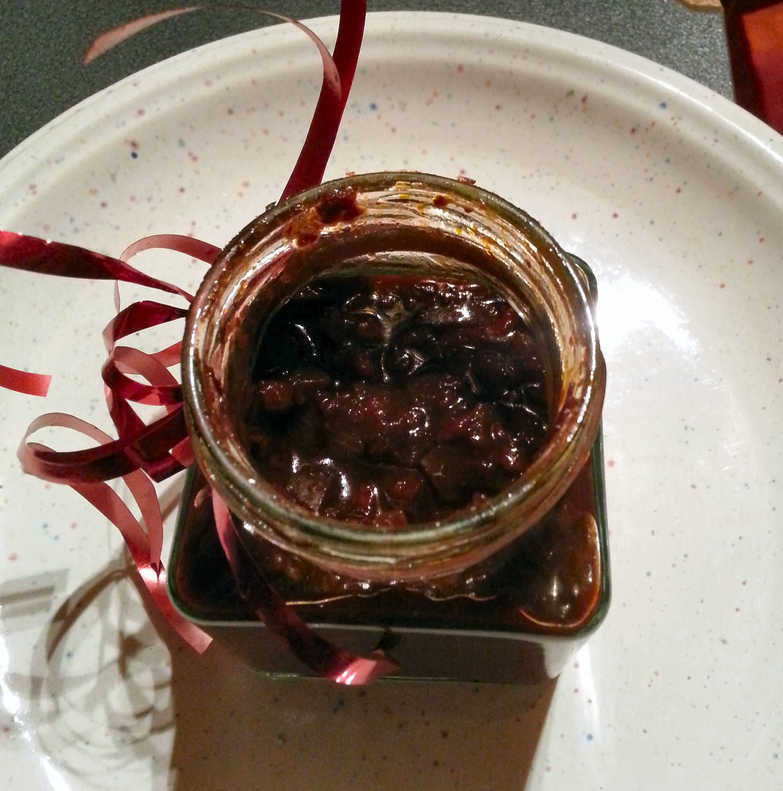
Thanksgiving Saturday

It's Thanksgiving (recently), for Americans. It's Saturday for us. It's Thanksgiving Saturday for Becky - an American who lives with us!
So once again the Grecky partnership invited a bunch of us to celebrate their belated special day and pretend like they have a real American family. With which we are happy to oblige.
Although we aren't expected to bring anything I usually like to turn up with a dish or two, this year I had a go at a couple of fine American traditions: ranch dressing and a spicy novelty cornbread. Plus this year I got a special bonus - Nicky made me a birthday pot of delicious chilli chutney. After much prompting she admitted that it's actually a Jamie Bastard Oliver recipe, but it was so tasty I'll forgive her!
Happy Un-Holiday!
Skillet Cornbread with Cranberries and Roast Jalapeños
bread veg
Is it a griddle pan? Is it a skillet?
The Le Creuset one I bought calls itself a griddle pan, but it looks more like the dictionary definition of a skillet as a small frying pan.
Whatever - it makes damn fine cornbread.
The Le Creuset one I bought calls itself a griddle pan, but it looks more like the dictionary definition of a skillet as a small frying pan.
Whatever - it makes damn fine cornbread.
Makes about 1½ pints - enough to fill a 10" skillet
Ingredients
- 1 tablespoon butter or vegetable oil for greasing the skillet
- ½ cup plain flour
- 1 cup cornmeal, preferably stone-ground
- 4-5 jalapeño peppers (or to taste), roasted, finely chopped and pounded
- 3-4 tablespoon chopped fresh coriander/cilantro
- 1 cup dried cranberries, (or to taste) slightly bruised
- 4 tablespoon honey
- 3½ teaspoons baking powder
- 1 teaspoon salt
- about 15-20 turns of freshly ground black pepper
- approximately 1 cup buttermilk (a little bit more or less; enough to make cake like batter)
- 2 eggs, lightly beaten
- 5½ oz unsalted butter, melted or any cooking oil
Preheat the oven to 400°F/200°C/Gas Mark 6.
Put in a 10" skillet to heat up.
In a bowl, sift the flour with the baking powder and salt. Stir in the cornmeal.
Grill the peppers until their skins char, turning them so they don't burn. Put them in a plastic bag to cool. Then peel off the skin and remove the stems and seeds. Chop them.
Pound the jalapeños, black pepper and the fresh coriander leaves until it is coarse paste.
Bruise the cranberries a little so they are slightly broken, then add to the flour and toss them through.
Whisk most of the buttermilk, honey and eggs in a different bowl and stir in lightly with the flour mix.
Add the last of the buttermilk gradually to achieve a pourable cake-like batter.
Add the coriander and jalapeño paste.
Add the melted butter and stir just until blended.
Heat the cast iron skillet on the stove top or in the oven until it is really hot. When the dough is added it should sizzle loudly.
Add 1 tablespoon of oil or butter, then pour in the batter.
Transfer the skillet to the oven, turn down slightly I set it to Gas 5½ and bake for about 15-20 minutes, or until the center springs back when gently pressed.
The bread should be golden brown and crispy at the edges.
Turn the corn bread out onto a rack to cool and slice only when cooled.
In a bowl, sift the flour with the baking powder and salt. Stir in the cornmeal.
Grill the peppers until their skins char, turning them so they don't burn. Put them in a plastic bag to cool. Then peel off the skin and remove the stems and seeds. Chop them.
Pound the jalapeños, black pepper and the fresh coriander leaves until it is coarse paste.
Bruise the cranberries a little so they are slightly broken, then add to the flour and toss them through.
Whisk most of the buttermilk, honey and eggs in a different bowl and stir in lightly with the flour mix.
Add the last of the buttermilk gradually to achieve a pourable cake-like batter.
Add the coriander and jalapeño paste.
Add the melted butter and stir just until blended.
Heat the cast iron skillet on the stove top or in the oven until it is really hot. When the dough is added it should sizzle loudly.
Add 1 tablespoon of oil or butter, then pour in the batter.
Transfer the skillet to the oven, turn down slightly I set it to Gas 5½ and bake for about 15-20 minutes, or until the center springs back when gently pressed.
The bread should be golden brown and crispy at the edges.
Turn the corn bread out onto a rack to cool and slice only when cooled.
I kid you not, that's what it's called :(
Jamie Oliver's Cheeky Chilli-Pepper Chutney
pickle veg vegan
Oooh a cheeky chutney!
Mockney tosser.
S'alright though :(
S'alright though :(
Makes 500g
Ingredients
- 8-10 fresh red chillies
- 8 ripe red peppers
- olive oil
- 2 medium red onions, peeled and chopped
- 1 sprig fresh rosemary, leaves picked and chopped
- 2 bay leaves
- 1 x 5 cm stick cinnamon
- sea salt
- freshly ground black pepper
- 100 g brown sugar
- 150 ml balsamic vinegar
If you want your chutney to last for a while, make sure you have some small sterilised jars ready to go.
Place your chillies and peppers over a hot barbecue, in a griddle pan or on a tray under a hot grill,
turning them now and then until blackened and blistered all over.
Carefully lift the hot peppers and chillies into a bowl (the smaller chillies won't take as long as the peppers so remove them first)
and cover tightly with cling film. As they cool down, they'll cook gently in their own steam.
By the time they're cool enough to handle, you'll be able to peel the skin off easily.
When you've got rid of most of the skin, trimmed off the stalks and scooped out the seeds, you'll be left with a pile of nice tasty peppers and chillies. Finely chop by hand or put in a food processor and whiz up. Then put to one side.
Heat a saucepan and pour in a splash of olive oil. Add the onions, rosemary, bay leaves and cinnamon and season with a little salt and pepper. Cook very slowly for about 20 minutes or so, until the onions become rich, golden and sticky.
Add the chopped peppers and chillies, the sugar and the vinegar to the onions and keep cooking. When the liquid reduces and you're left with a lovely thick sticky chutney, season well to taste. Remove the cinnamon stick and the bay leaves. Either spoon into the sterilised jars and put them in a cool dark place, or keep in the fridge and use right away. In sterilised jars, the chutney should keep for a couple of months.
When you've got rid of most of the skin, trimmed off the stalks and scooped out the seeds, you'll be left with a pile of nice tasty peppers and chillies. Finely chop by hand or put in a food processor and whiz up. Then put to one side.
Heat a saucepan and pour in a splash of olive oil. Add the onions, rosemary, bay leaves and cinnamon and season with a little salt and pepper. Cook very slowly for about 20 minutes or so, until the onions become rich, golden and sticky.
Add the chopped peppers and chillies, the sugar and the vinegar to the onions and keep cooking. When the liquid reduces and you're left with a lovely thick sticky chutney, season well to taste. Remove the cinnamon stick and the bay leaves. Either spoon into the sterilised jars and put them in a cool dark place, or keep in the fridge and use right away. In sterilised jars, the chutney should keep for a couple of months.
Yeah yeah. It's tasty.
Thanks Jamie.
Thanks Jamie.
OMG 50th Birthday Reunion

Ah the food, the wine, the company!
One day soon, or perhaps not so soon, I'll write all about it?
On the other hand, maybe I'll just load all the photos from my fabulous fun weekend at Eyemouth aboard yacht Erin, and hosted by The Churches Hotel, into one vast gallery and let you all just revel in the the glory that was:
Happy OMG 50th Birthday To Me!

Half a century!
In the words of my good friend H.G. No one would have believed in the last years of the 20th Century that Karl would survive this long.
Least of all me.
I once had hopes of going out spectacularly, in a blazing car wreck or drowned in my own vomit but then the third time I almost died was particularly disappointing - I got myself caught in a tumbling wave while surfing off Huntingdon Beach and nearly drowned.
How mundane!
Things seemed more promising the last time I tried to count the number of road accidents I've had and had to give up when I reached 50, but then I haven't had a serious crash for a decade now so that exit seems increasingly unlikely.
It's starting to look like the best I can hope for is my fall-back plan of making it through to the end of the world and getting to watch the apocalypse from a remote mountaintop on the reasonable basis that if I can't enjoy living any more no one else should be able to.
But it better hurry up and get here - I'm not getting any younger.
Time to throw another baby seal on the Amazonian forest-fire I reckon.
I celebrated my 50th Birthday by going to work like a drone as normal. Well, it's not like Karl's OMG Birthday Week is a holiday or anything.
My colleague Dave has a good take on that subject - he figures everyone should be entitled to their own personal public holiday on their birthday. Which gets my vote.
My ex-colleague Dave that is. Unfortunately Dave left.
He used to be my boss at work, and a thoroughly decent manager he was too - assiduously protecting us underlings from the endless STUPID running rampant through the higher echelons of company command.
So of course he had to go.
Before he left, though, he recommended Zizzi's Seasonal Special Agro Dolce Pizza, which I offer for your amusement.
Anyway, where was I? Oh yes, my birthday.
Well, things picked up in the evening when Flora took me to dinner at the relatively new 21212. It's been open since 2009, but I've never been there before so I was really looking forward to it - it's one of the (currently) five Michelin starred eateries in Edinburgh.
Gotta catch 'em all :)
The first three courses were really quite good particularly their amusing novelty fruit leathers, it's just a pity we didn't make it to dessert before Flora disgraced herself in their bathroom and we had to leave. Hurriedly.
Some women just can't take their port!
Next!
Zizzi's Agro Dolce Pizza
main veg
As recommended by my (ex) colleague Dave in glowing terms,
though how much of that has to do with him being a vegetarian I'll leave you to decide.
Zizzi's own advertising claims It really shouldn't work, but it does! I'd be inclined to endorse the first part ;)
Zizzi's own advertising claims It really shouldn't work, but it does! I'd be inclined to endorse the first part ;)
Ingredients
toppings for half of the pizza:- mushrooms
- thyme
- mascarpone
- mozzarella
- a drizzle of truffle oil
toppings for the other half:- speck ham or artichoke for the meat intolerant
- pumpkin, cooked, mashed
- mascarpone
- amaretti biscuit, crumbled
Cook and mash the pumpkin to a thick sauce.
Make your favourite pizza dough, roll out the base and cover half of it with the first set of toppings, then drizzle it with truffle oil.
Top the second half, then crumble up amaretti biscuits and sprinkle over.
Cook
Make your favourite pizza dough, roll out the base and cover half of it with the first set of toppings, then drizzle it with truffle oil.
Top the second half, then crumble up amaretti biscuits and sprinkle over.
Cook
I dunno - sounds weird.
Might try it sometime though - Dave has made some sound recommendations in the past!
Might try it sometime though - Dave has made some sound recommendations in the past!
Bob's Birthday Burning, a Bonfire and a Barbecue

That's my birthday - not Bob's.
My 50th in fact. OMG.
I'm not a big fan of my birthdays as a rule. I'd much rather ignore them, or pretend they aren't happening. In fact usually my (girl) friends seem more interested in marking them than I do.
Girlies are always suckers for birthdays: Eldoradoes - I'm looking at you!
This year feels a bit different though - it would seem churlish not to mark the fact that I've made it to a half-century, against all expectations, plus to be honest I'm starting to feel some twinges of mortality - as if my body isn't really going to last forever. Grey hairs are now sprouting like pigs bristles from the most unlikely of places and my belly button seems to be determined to make a break for freedom.
So I figure I better make the most of this Birthday, in case the rest of them aren't much fun.
By booking a whole week of entertainment!
To kick things off I took the opportunity to ceremonially rid myself of the wooden albatross known as Bob - my dilapidated wooden dinghy. He's an old development-class Cherub once upon a time constructed by someone in their garage who had too much time and plywood on their hands, but he hasn't sailed on the open water for a couple of years now. He just sits on the tarmac at Port Edgar Marina soaking up hundreds of pounds in berthing fees every year.
Bob was once a fine figure of a boat and he has provided us with a fair amount of fun in his time - I have particularly fond memories of a three-men-in-a-tub expedition around the Beamer lighthouse in a raging storm with two heavyweight buddies (sorry buddies - you know it's true) which required as much bailing as sailing.
Unfortunately the last few times on the water have resulted in Bob having to be rescued from certain calamity, either because of important bits falling off, or because he simply started to sink.
So Viking funeral time.
It would have been nice to sail him off somewhere isolated and scenic, like Inchkeith Island but scenic, for his funeral pyre, but I was afraid that without an inordinate amount of time, energy, or money being spent on him he was depressingly unlikely to make it out of the harbour. Plus I couldn't find anyone stupid brave enough to come with me.
Fortunately my friends the Brians kindly offered their extensive property for a Bob Burning Party, plus a road trailer to get him there. So we made an event out of it, barbecue, fireworks, and pumpkin carving contest. The whole nine yards.
Thanks Brians! Wonder what they'll do with all those leftover pumpkins?
My first Birthday present being a handy Costco card (Thanks Alex!) I was able to get a reasonable deal on the barbecue meat, plus a vast bottle of Buffalo Sauce - and my favourite butcher provided the rest. He had some very decently priced wild boar belly so I made up a batch of wild boar and maple syrup sausages highly recommended, as well as 3lb of pork, sun-dried tomato, feta and rosemary sausages good - tastier than the last tomato round. Since the meat grinder was already out, I also had a bash at making some spicy lamb burgers (Thanks Tony Singh!).
The sausages were both well-received, and not to blow my own trumpet, delicious.
Unfortunately I had to hide the lamb burgers, since they were clearly never going to hold up through the grilling process. I had to take them home to fry in a pan! Really carefully.
I took a leaf out my American friend Becky's book and served up barbecued chicken wings with the bottle of hot sauce and freezer bags for people to dip them into à la Buffalo (Thanks Becky!), and I relearned something about organising a barbecue:
- Start it going at least an hour before people are due to turn up. That gives you half an hour to get the charcoal glowing and another half hour to have a stack of cooked meat ready to feed them with the instant they arrive. Expectant and starving.
And the winners of the Pumpkin Carving Competition are:
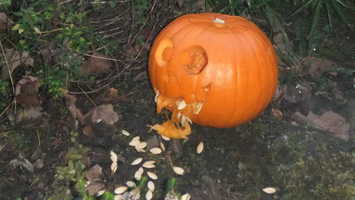
|

|

|
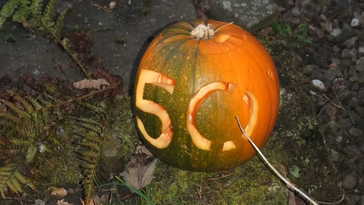
|
| For inventive use of pumpkin innards | For scare value. | Wins the car grill look-alike prize. | For age-appropriateness. |
Buffalo Wings
side snack fowl
It's hard to tell exactly which is the authentically original buffalo wing sauce.
My American friend Becky votes for the hard-to-find Original Anchor Bar Buffalo Wing Sauce , but on the other hand Costco stocks Frank's.
So Frank's it is!
My American friend Becky votes for the hard-to-find Original Anchor Bar Buffalo Wing Sauce , but on the other hand Costco stocks Frank's.
So Frank's it is!
Rumour has it that the original dressing was actually just Frank's (or any Cayenne hot sauce like Durkee's or Tabasco) and butter anyway.
Just like the recipe below.
Yeehaw!
If you're doing these on the barbecue then you can just hand out freezer bags with the bottled sauce
so people can fill the bags and do their own dipping and coating.
Just like the recipe below.
Yeehaw!
Serves a bar-full
Ingredients
- hundreds of chicken wings
- fat for deep-frying
- a cayenne pepper hot sauce
- butter
- blue cheese dip or ranch dressing
- celery
Dry the chicken wings thoroughly. You can season them if you like, though this seems heretical to some.
Heat the oil to 375-400°F (190-200°C); a cube of bread will sizzle when dropped in.
Fry the chicken wings until crisp and golden: about 10 minutes.
It's traditional to serve the dip with a stick of celery. Go figure.
Heat the oil to 375-400°F (190-200°C); a cube of bread will sizzle when dropped in.
Fry the chicken wings until crisp and golden: about 10 minutes.
You could also try
double-frying the wings for extra crispiness,
frying at a lower temperature (250°F/120°C) first until they are lightly coloured, then finishing in hotter oil.
Meanwhile heat up your favourite buffalo wings sauce with between half and an equal volume of butter until the butter melts.
I'd go with an equal volume :)
If you like you can also add extra seasonings (herbs, Worcestershire sauce, chilli powder, paprika, hot sauce, vinegar, garlic powder or anything else you fancy) and simmer the mixture for a while.
When the wings are ready toss them with the sauce in a bowl.
You can also simmer them up in the sauce if you prefer.If you like you can also add extra seasonings (herbs, Worcestershire sauce, chilli powder, paprika, hot sauce, vinegar, garlic powder or anything else you fancy) and simmer the mixture for a while.
It's traditional to serve the dip with a stick of celery. Go figure.
Porky Bellies

It's long overdue, but last night I extruded my first sausage!
Last Christmas (is it only last Christmas??) Mum bought me a sausage machine.
Yes, I know I put it on my Christmas list, but then I put a yacht and a motorbike on my Christmas list, so I never expected to get one. I couldn't have been more surprised to discover it hiding under my Christmas Morning pile of goodies from Santa if I'd woken up with my head stapled to the pillow!
And now a mere 10 months later I've finally taken the beast out of its box and played with it - you know I don't like to rush these things.
It turns out that making sausages is an awkward, fiddly, messy pain in the backside. In other words it requires some practice and a little skill.
I went down to my favourite butcher to talk turkey, er sausages, and buy the casings. I've always been particularly fond of tomato sausages so I thought I should have a go at those to start with, using sun-dried tomatoes, some extra tomato paste (the butcher's suggestion) and adding some basil to the mix. The butcher recommended I try belly pork, rather than the more usual shoulder (cheaper, no need for extra fat though possibly less flavour), so I bought a massive slab and saved half of it to make one of Shane Osborne's starters that I've quite fancied trying for a while.
So it's not as easy as I might have hoped to get the sausage skins onto the feeder, like trying to roll on a metre long condom. Now I know why condoms are lubricated - a thorough soaking of the sausage casing in warm water really helps (it turns out). Then you have to fill the skins smoothly and evenly - not surprisingly I ended up with a lot of hamburger meat from splitting overfilled sausages, and a lot of pork mousse from over-mincing. But I'm sure I'll get better with practice, and even the mousse tasted quite nice, even if I was a bit cautious with the tomato flavour this time.
Flora was lucky enough to be the first to be invited to taste my sausage, and I made us a nice upmarket bangers and mash for dinner. We kicked off with that Crispy Pork Belly with Apple & Frisée Salad made with the pressed leftover sausage belly (delicious!), then those sausages with seasonal mash with pumpkin and red onion, cleansing green beans with lemon and black olives, and a slightly spicy chilli ginger tomato gravy.
In classic eating-for-the-end-of-days winter meal style we finished off with a massive baked toffee apple pudding consisting of mostly hot sugar.
From belly pork to a porky belly. Now bring on the apocalypse!
For what it's worth here's my dinner plan - it failed at the point of putting in the pudding though, since we had to watch some Big Bang Theory first while waiting for the sausage to settle.
Chilli Ginger Tomato Sauce
sauce veg vegan
This is a variation of a sauce I tried once before
as an accompaniment to battered fish.
I think roasting the veggies works better than grilling them, plus you end up with a hot sauce.
Although I did finish off the tomatoes under the grill to char them up a little, you probably don't need to.
I served it up without the oil (which I forgot) and it made an excellent gravy with sausages and mash.
Sauce or gravy - you decide.
I think roasting the veggies works better than grilling them, plus you end up with a hot sauce.
Although I did finish off the tomatoes under the grill to char them up a little, you probably don't need to.
I served it up without the oil (which I forgot) and it made an excellent gravy with sausages and mash.
Sauce or gravy - you decide.
Serves 4
Ingredients
- 8 medium vine tomatoes
- 1-2 red chillies, deseeded
- 3 cloves garlic, peeled, roughly sliced
- 1 small red onion or shallot, peeled, sliced
- 2" piece root ginger, peeled, sliced
- 1 tablespoon dark brown sugar
- a few sprigs thyme, leaves only
- pinch of salt
- juice of about ½ lemon
- 2 fl oz/50ml olive oil optional
Lay a bed of the sliced vegetables in a casserole dish.
Scatter on the sugar and a pinch of salt.
Sit the tomatoes on top and cut small crosses in the top of each one.
Bake at Gas Mark 6 (or whatever you are using) until the tomatoes are collapsing or the vegetables are starting to caramelize. Finish off under the grill to char the tomatoes a little if you can be bothered.
Whizz up with a splash or two of lemon juice in a blender then pass through a sieve.
Taste, season with salt, pepper and more lemon juice.
Whisk in the olive oil if you like.
Serve dressed with chopped chives and lemon zest if you like.
Scatter on the sugar and a pinch of salt.
Sit the tomatoes on top and cut small crosses in the top of each one.
Bake at Gas Mark 6 (or whatever you are using) until the tomatoes are collapsing or the vegetables are starting to caramelize. Finish off under the grill to char the tomatoes a little if you can be bothered.
Whizz up with a splash or two of lemon juice in a blender then pass through a sieve.
Taste, season with salt, pepper and more lemon juice.
Whisk in the olive oil if you like.
Serve dressed with chopped chives and lemon zest if you like.
A nice sauce/gravy for your sausage and mash without the oil.
It might even make reasonable a dipping sauce for battered fish, though it's quite thin.
It might even make reasonable a dipping sauce for battered fish, though it's quite thin.
You could add a red bell pepper to the mix - roasted would be good too - to thicken and add a touch of sweetness.
Green Beans with Lemon and Black Olives
side veg vegan
Simple enough - and quite a clean, fresh combination.
Ingredients
- green beans, topped, tailed, halved or thirded Is that a word?
- black olives, sliced I like the dry-cured ones
- thinly pared lemon peel
- garlic clove, pressed or mashed optional
- olive oil
- seasoning
Cook the beans briefly in boiling water until cooked, but still snappy (5-10 minutes).
Drain. Stir through the olives and lemon peel, garlic (if using), a drizzle of olive oil and season.
Drain. Stir through the olives and lemon peel, garlic (if using), a drizzle of olive oil and season.
Not a bad combination. Different from an
earlier round with lemon and capers
Toffee Apple Pudding
dessert veg
An extremely sweet apple sponge
I wanted an apple-based dessert to mirror the apples in my starter, and this came up in Google.
It sounded more interesting than just stuffing some apples with raisins and baking them,
which was my backup plan, so I gave it a go.
I hadn't really appreciated until it came to eating it just how much sugar is involved - 250g - that's a half-pound of sugar in old money!
Death by diabetes indeed! Probably best not served to children, though I'm sure you could cut down on the sugar quantities - particularly in the sponge batter, and add more apple.
I hadn't really appreciated until it came to eating it just how much sugar is involved - 250g - that's a half-pound of sugar in old money!
Death by diabetes indeed! Probably best not served to children, though I'm sure you could cut down on the sugar quantities - particularly in the sponge batter, and add more apple.
Serves 6
Ingredients
- 85g/3oz butter, melted
- 140g/5oz self-raising flour
- 100g/3½oz golden caster sugar
- 1 tbsp baking powder yes - a tablespoon
- 200ml/7 fl oz milk
- 1 egg, beaten
- 1 tsp vanilla extract
- and maybe a dash of cinnamon?
- 2 Bramley apples (or other cooking) apples, peeled, cored and sliced
For the topping:- 250ml/9 fl oz boiling water
- 140g/5oz dark brown sugar I used a dark Muscovado
- 50g/2oz pecans, roughly chopped though I used walnuts - to no ill effect
Heat oven to 180°C/fan 160°C/gas 4.
Grease a 2-litre/3-pint ovenproof dish lightly with butter. Tip the flour, sugar and baking powder, along with a pinch of salt, into a large bowl.
Mix together the milk, butter, egg and vanilla extract and stir into the dry ingredients until you get a smooth batter.
Grease a 2-litre/3-pint ovenproof dish lightly with butter. Tip the flour, sugar and baking powder, along with a pinch of salt, into a large bowl.
Mix together the milk, butter, egg and vanilla extract and stir into the dry ingredients until you get a smooth batter.
My butter, and hence my batter, was a bit lumpy since I only softened it without melting, but it didn't seem to matter.
Arrange the apples in the dish, spoon the batter on top and smooth with a knife until the apples are covered.
I didn't cut my apples too thinly, which perhaps contributed to the extra cooking time.
Be sure to use tart apples - there's more than enough sweetness involved already.
For the topping, pour 250ml boiling water over the sugar and stir together until smooth.
Pour the liquid over the pudding mixture, then scatter over the pecans.
Be sure to use tart apples - there's more than enough sweetness involved already.
This feels decidedly weird, but it all soaks through just fine.
I scattered the pecans first, which maybe gave them a better crispy coating.
Bake for about 40 mins until the pudding has risen and is golden.
I scattered the pecans first, which maybe gave them a better crispy coating.
Mine took an hour, and unless you used a really shallow dish I don't see it ever taking much less if you want the apples to be cooked -
it's a big pudding.
I also turned the oven down a little so as not to overcook the top.
Test the centre with a skewer. It should be hot, and the apples soft.
Use a big spoon to serve the pudding, making sure you get some of the gooey caramel sauce covering the bottom of the dish.
Test the centre with a skewer. It should be hot, and the apples soft.
Oh yes, heaven forbid anyone should miss out on their diabetic overload!
Serve with pouring cream, warm custard or vanilla ice cream crème frâiche or perhaps a shot of insulin?.
It's pretty good actually and very simple, but a bit of a sugar overload.
And the gooey caramel sauce is really just sugary water.
And the gooey caramel sauce is really just sugary water.
101 Uses for Leftover Yoghurt Sauce

Well, 2 uses for leftover yoghurt sauce at least.
Every so often I'm overcome with a nostalgic desire to get absolutely pissed and furiously consume one of the frozen Spicey Cottage Curries (Karahi Gosht - extra spic"e"y) that my Mum brings up for me from her (and once my) local curry shop.
It's a complicated ritual that involves laying in a stock of Marston's Strong Pale Ale (a fine brew which is both delicious and reasonably priced, not to mention 6.2% ABV, which possibly explains why they seem to no longer make it, the nannyist bollocks), making up a nice soothing pot of yoghurt sauce and running a bubbling foam bath in preparation for the evening's entertainment. This may seem a lot of effort, but it does have the benefit of cutting out the tedious need to spend the night pub-crawling through Wibsey trying to get loaded enough to really enjoy the curry at its source.
First I stick a few starter beers in the freezer, make up a vat of the yoghurt sauce du jour (they're all a bit random as to quantities and precise ingredients, but it's hard to go wrong), then I roll out the seeds from a half-dozen or two thin green chillies and slice them over the top of the frozen curry, put the lid back on the tin-foil container and pop it into the oven on its lowest setting. Then it's into the bath with some bubbles, the first beer and Radio4 Extra for company.
Luxury.
The curry is ready to eat when the mouth-watering smell of it fills the house, and you can't resist its call any longer.
Or you regain consciousness in a cold bath. Whichever comes first.
Usually I end up having to make too much yoghurt sauce for just the one meal, it being too hard to grind up fewer ingredients, so I have to think of things to do with the leftover.
Obviously I can make up more curries to eat with it, but it also makes a reasonable topping for a spicy soup if you happen to have a bunch of vegetables that need boiling hanging around and some trahana to bolster them with.
This time I thought I'd see what it's like as a marinade, so I poured the leftover sauce with a bit of extra garlic over a couple of pork chops and stuck them in the fridge for a day. I made up a quick curry with some frozen peas, a small pot of rice, and stuck the chops under the grill. Shake off excess sauce first - or it'll just burn.
To be honest the sauce isn't really rich or complex enough to impart all that much flavour to the pork, even if it does a reasonable job of tenderising the meat though it takes a day or two. Of course you can always add spices to boost its potency.
The peas were better than the pork :)
I used the rest of the sauce to whip up an Aloo Dom adding a bit of extra grated ginger root to fry up with the coated, par-boiled potatoes in a generous amount of oil to give some extra crispiness before adding the sauce (as was - except for a bit of extra salt and the obligatory extra chillies) and simmering until tender.
That worked pretty well.
Of course, now I've got leftover curries from the leftover sauce, which I need to make more curries to eat with, like this delicious achar gosht or these not-quite-so-successfull tandoori aubergines, and before you know it I've returned to the days of endless curries and the terrifying cycle repeats.
Coconut Pea Curry
curry side veg
Pea curry with coconut and curry leaves.
A quick and clean pea curry - that doesn't adulterate their freshness overmuch.
Serves 4
Ingredients
- ghee or oil
- generous ½ teaspoon black mustard seeds
- generous ½ teaspoon yellow mustard seeds
- 1lb/500g fresh or frozen peas
- half-dozen spring onions
- pinch or three of dried curry leaves
- 2 tablespoons coconut powder or coconut cream
- ½ teaspoon salt
- a little water
Throw the curry leaves into a little boiling water to soften.
Dissolve the coconut powder in a half cup of water (mixing the water into the powder gradually) if using.
Chop the spring onions.
Heat the ghee or oil and fry the mustard seeds until they start to pop.
If you're using fresh peas throw the spring onions into the pot, quickly followed by the peas. If you're using frozen peas, just add them straight away and throw in the spring onions on top.
Stir in the coconut, salt, and the soaked curry leaves with their water.
Seal tightly and simmer gently for 5-10 minutes until the peas are cooked and the curry leaves softened.
Serve dressed with a little mustard oil.
Dissolve the coconut powder in a half cup of water (mixing the water into the powder gradually) if using.
Chop the spring onions.
Heat the ghee or oil and fry the mustard seeds until they start to pop.
If you're using fresh peas throw the spring onions into the pot, quickly followed by the peas. If you're using frozen peas, just add them straight away and throw in the spring onions on top.
Stir in the coconut, salt, and the soaked curry leaves with their water.
Seal tightly and simmer gently for 5-10 minutes until the peas are cooked and the curry leaves softened.
Serve dressed with a little mustard oil.
Really rather tasty!
Leave the curry leaves softening in a little water for a while first if you have the time - it will save overcooking the peas.
I think a little grated ginger added just before the peas wouldn't go amiss.
Leave the curry leaves softening in a little water for a while first if you have the time - it will save overcooking the peas.
I think a little grated ginger added just before the peas wouldn't go amiss.
Achar Gosht
Lamb and Pickle Curry
Lamb and Pickle Curry
curry main meat
I've always liked this in the restaurants, but this is the first time I've had a go at making it.
It's surprisingly simple. If your lamb is very lean you won't need to pre-fry it at all - I just do that to render any fatty pieces.
Serves 4
Ingredients
- ghee
- 2 medium onions
- half dozen garlic cloves
- couple inches root ginger
- chilli powder to taste
- 1 teaspoon salt
- 2 tablespoons curry powder
- 1-2 tablespoons vinegar I used sherry vinegar
- couple tablespoons tomato purée
- 1 aubergine cut into 1½" cubes
- 1½ lb lamb, cut into 1½" cubes
- 2-4 tablespoons lime or aubergine pickle, roughly chopped
- 1 mango
- a few tablespoons chopped fresh coriander leaves
preheat the oven to 375°F/190°C/Gas 5.
Purée the onion, garlic and ginger root together. Add a little water if necessary.
Cut the aubergine and lamb into decent chunks: 1"-2" cubes.
Mix the powders with enough vinegar to make a thick paste. I added half a teaspoon of chilli powder and also a teaspoon each of ground coriander, cumin and turmeric to freshen the curry powder. .
Heat a heavy casserole and lay in any fatty cubes of lamb, fat side down. Allow the fat to crisp up without drying out the meat, then scoop out the cubes with a slotted spoon and set aside with any uncooked lean cubes.
Add plenty of ghee to the pot and gently fry the purée until the bitter smell has gone and the oil begins to separate.
Add the spice paste and fry until the harsh smell has gone and the oil separates again.
Add the tomato purée and fry until the oil separates again.
Stir in the lamb to coat well, then add the aubergine. Add a couple of tablespoons of the pickle, roughly chopped. If you use aubergine (brinjal) pickle you can probably add more, but hot lime pickle is quite strong. Heat through, put on the lid and stick the casserole in the oven.
Cut the mango into 1" cubes and chop the coriander leaves.
After 20 minutes take out the casserole, stir and taste. Add more pickle if you like, and a little stock if it seems too dry, not too much though - you want it dry.
Put back in the oven and cook for another 20-30 minutes until the lamb is tender.
Stir in the mango and coriander, put the casserole back in the oven and turn it off. Leave for 10-15 minutes for the flavours to mature.
Serve with pooris or rice and a minty yoghurt sauce.
Purée the onion, garlic and ginger root together. Add a little water if necessary.
Cut the aubergine and lamb into decent chunks: 1"-2" cubes.
Mix the powders with enough vinegar to make a thick paste. I added half a teaspoon of chilli powder and also a teaspoon each of ground coriander, cumin and turmeric to freshen the curry powder. .
Heat a heavy casserole and lay in any fatty cubes of lamb, fat side down. Allow the fat to crisp up without drying out the meat, then scoop out the cubes with a slotted spoon and set aside with any uncooked lean cubes.
Add plenty of ghee to the pot and gently fry the purée until the bitter smell has gone and the oil begins to separate.
Add the spice paste and fry until the harsh smell has gone and the oil separates again.
Add the tomato purée and fry until the oil separates again.
Stir in the lamb to coat well, then add the aubergine. Add a couple of tablespoons of the pickle, roughly chopped. If you use aubergine (brinjal) pickle you can probably add more, but hot lime pickle is quite strong. Heat through, put on the lid and stick the casserole in the oven.
Cut the mango into 1" cubes and chop the coriander leaves.
After 20 minutes take out the casserole, stir and taste. Add more pickle if you like, and a little stock if it seems too dry, not too much though - you want it dry.
Put back in the oven and cook for another 20-30 minutes until the lamb is tender.
Stir in the mango and coriander, put the casserole back in the oven and turn it off. Leave for 10-15 minutes for the flavours to mature.
Serve with pooris or rice and a minty yoghurt sauce.
Bloody delicious!
Don't overdo the pickle - it can be a bit intense.
If you like you could fry some carrot chunks or cauliflower after the tomato purée or separately fry up some potato cubes and throw them in with the lamb too.
Don't overdo the pickle - it can be a bit intense.
If you like you could fry some carrot chunks or cauliflower after the tomato purée or separately fry up some potato cubes and throw them in with the lamb too.
I made this again without bothering to pre-fry my (pretty fatty) lamb shoulder cubes - and it was just as lovely.
I made the curry powder from grinding
I made the curry powder from grinding
- 1 tsp fenugreek seeds
- small stick cassia
- 4 cloves
- 2 tsps dried fenugreek leaves
- 2 tsps dried curry leaves
- 1 tsp cumin powder
- 1 tsp coriander powder
- 1 tsp turmeric
- 1 tsp mustard powder
- 1 tsp chilli powder
- 1 tsp ground black pepper
Tandoori Aubergine
curry side veg
I made this since I had some spare tandoori paste that needed using up, and was grinding up some onion, garlic ginger paste for another dish.
I doubt you would bother to grind up only a tablespoon otherwise.
I'm sure you could do the same thing with any other solid vegetable - cauliflower, courgette, potato, even onions
If you're going to skewer them you probably want hefty chunks of vegetable, rather than the slices below.
I'm sure you could do the same thing with any other solid vegetable - cauliflower, courgette, potato, even onions
If you're going to skewer them you probably want hefty chunks of vegetable, rather than the slices below.
Serves 4
Ingredients
- 2 aubergines
- 2-3 tablespoons tandoori paste
- 1 tablespoon yoghurt
- 1 tablespoon ground onion/garlic/ginger purée
Grind up your tablespoon of onion, garlic and ginger(!)
Slice the aubergines lengthwise about 1" thick, salt and leave in a colander to drain for 15 minutes or so.
Pat dry, rinsing off excess salt if necessary, then coat with the tandoori paste mixture and leave to marinate for a couple of hours.
Preheat the oven to moderately hot - Gas Mark 5/190°C. Lay in a single layer in an oven tray, or thread onto skewers, drizzle with a little oil, and bake until golden. Baste with oil occasionally.
Slice the aubergines lengthwise about 1" thick, salt and leave in a colander to drain for 15 minutes or so.
Pat dry, rinsing off excess salt if necessary, then coat with the tandoori paste mixture and leave to marinate for a couple of hours.
Preheat the oven to moderately hot - Gas Mark 5/190°C. Lay in a single layer in an oven tray, or thread onto skewers, drizzle with a little oil, and bake until golden. Baste with oil occasionally.
I baked mine layered in a Pyrex dish, and though they tasted good enough, they inside layers didn't crisp up at all,
but looked a bit soggy and vaguely green.
Mind you I did also rub my aubergines with mango powder and turmeric before smearing on the tandoori paste, which may not have helped: I was a bit short of tandoori paste.
Mind you I did also rub my aubergines with mango powder and turmeric before smearing on the tandoori paste, which may not have helped: I was a bit short of tandoori paste.
Tickling Seafood Allergies in Eyemouth

An overnight trip down the river in slim company to Eyemouth.
Possibly due to the complete failure of the yacht club, during the upheaval of the building of a new Forth crossing, to advertise the race, or maybe just part of the steady decline of sailing around these parts, for whatever reason this year's Convoy Cup race featured only two lonely entrants - ourselves and a Fisher Row Moody 27 Bilge Keeler called Sulumar.
As you can imagine - we fancied our chances for a prize, but sadly despite beating the competition by 1½ hours over the five hour race, we still lost by an hour on corrected time. Damn these handicappings are harsh!
Still we got to eat well on the way there!
Eyemouth has suffered for as long as I've been going there with having nowhere worthwhile to eat. Though the fish shop is perfectly adequate, the only other restaurant fish available seems to be frozen or breaded pap courtesy of Captain Birdseye, and I consider my meal at the local gastric pub "The Discontented Sole" to be amongst my most horrible dining experiences.
Fortunately these times are gone with the re-opening of the Churches Hotel and Seafood Restaurant under Lesley Orson and Lawson Wood, whose fishy skills we thoroughly tested whilst recovering from the race.
Or possibly from the GinAndTonics?
As dedicated followers of fashion will know I'm allergic to shellfish - have been ever since I stuck a prawn in my eye on the seafront at Leigh-On-Sea to impress my first proper girlfriend Louise and it blew up like a comedy eye balloon. So naturally I try to eat shellfish whenever I can, for one thing it's delicious, and for another I like to keep an eye on my reaction, so I'll know if it ever looks like ramping up and killing me. Provided it's only doing it pretty slowly, of course.
It's an odd thing actually - it doesn't happen with all shellfish and it doesn't seem to depend on how they're prepared. But the fresher they are the less they seem to affect me. Crustacae are the worst, mussels, scallops and squid give me just a little tickle, and oysters don't seem to affect me at all (touch mother-of-pearl).
So anyway, I couldn't resist the menu's Luxury crayfish and prawn cocktail. And luxury it was too. Hardly any life-threatening allergic reaction, a lovely rich creamy Marie Rose sauce (secret ingredient - mayonnaise!) and a delightful little salad dressed, as I was told, with a fragrant homemade herb oil. It took me ages to figure out where the occasional delicate bursts of basil were coming from!
If I have a complaint about the restaurant it's that they didn't have any tomato juice for my Bloody Mary. Bloody Hell!
Still I was suddenly struck with the idea of serving the Bloody Mary they didn't have in a giant beef tomato. With a straw sticking out. So struck in fact, that I had to make an immediate note in my brand new smartphone. Having recently lost my classic dumbphone I decided to finally bite the bullet and upgrade to the latest and greatest all-singing all-dancing smartassphone.
This modern technology is a white-knuckle ride people, and I'm still hanging on grimly. Ask me how it's going in a couple of years....
So, seeing as how my first course hadn't killed me, I had the scallops for my main. And such scallops I have never had. They tasted even fresher than ones I've cut open straight off a fishing boat, and these had been given just the merest hint of a scorching hot pan to give them a little caramelised glaze.
Beautiful. Though a bit skimpy if I'm honest - I was slightly jealous of the other dinners, but then I got to try them all anyway so that's alright then.
For dessert I chose the unlikely pairing of an undrinkably sweet, dark sherry called Pedro Ximénez (from the grape of the same name) and vanilla ice cream.
On it's own the wine tastes like alcoholic prune juice, though not alcoholic enough to be worth drinking, but paired with the ice cream there's an almost alchemical reaction which creates an inspired dish. Just pour the shot glass of sherry over the ice cream until balance is reached, then dig in.
And throw the rest of the sherry away!
Anyway, I liked the hotel so much that I bought the company. Well, OK, I just hired them out for my birthday party.
But to my bank account that's feeling like the same thing.
In an unrelated tickling I recently fed Flora some of Anthony Bourdain's Norman mussels (or molds as Google Translate unreliably informs me) which she ate with the gusto of two, huge blokes. That Bourdain - he may be a mercenary bastard and his food might be a bit rough around the edges, but he sure knows how to cook.
From his Les Halles cookbook
Anthony Bourdain's Moules Normandes
starter main fish
Mussels with Calvados
Must be served with a crusty white bread to soak up all the delicious juices.
Of which there are plenty!
Serves 4. Or 2 Floras
Ingredients
- ¼ pound (100g) slab bacon, cut into ½-inch/1-cm cubes
- 4 tablespoons (56g) butter
- 1 shallot, thinly sliced
- 6 small white mushrooms, thinly sliced
- ½ apple, cored, peeled, and cut into small dice or chunks
- 3 fl oz (75 ml) good Calvados
- glass of white wine or dry cider optional
- 1 cup (225 ml) heavy cream
- salt and pepper
- 6 pounds (2.7 kg) mussels, scrubbed and debearded (just before cooking)
In a small pot, cook the bacon over medium-high heat until the meat is brown and the fat has been rendered, about 10 minutes,
stirring occasionally to avoid sticking.
Scoop out the meat with a slotted spoon and reserve.
In a large pot, heat the butter with the bacon fat until it foams. Add the shallot and cook until soft, about 3 minutes.
Add the mushrooms and the apple and cook for 5 minutes.
Add the bacon and then stir in the Calvados, scraping the bottom of the pot with the wooden spoon to dislodge any good brown stuff that might be clinging there.
Add a splash of white wine, or cider if you like, and reduce a little.
Stir in the cream and season with salt and pepper.
Once the mixture has come to a boil, add the mussels and cover. Cook for 10 minutes, or until all of the mussels have opened. Shake. Cook for another minute. Shake again.
Serve immediately.
Scoop out the meat with a slotted spoon and reserve.
In a large pot, heat the butter with the bacon fat until it foams. Add the shallot and cook until soft, about 3 minutes.
Add the mushrooms and the apple and cook for 5 minutes.
Add the bacon and then stir in the Calvados, scraping the bottom of the pot with the wooden spoon to dislodge any good brown stuff that might be clinging there.
Add a splash of white wine, or cider if you like, and reduce a little.
Stir in the cream and season with salt and pepper.
Once the mixture has come to a boil, add the mussels and cover. Cook for 10 minutes, or until all of the mussels have opened. Shake. Cook for another minute. Shake again.
Serve immediately.
Veeeeery tasty!
Though there are quite a lot of bits in the sauce, which might be a presentational consideration.
If you want to go to a lot of effort you can quickly arrange the mussels spread open and standing upright in concentric circles in an enormous, shallow, heated serving dish starting from the outside and working them inwards and upwards. Finished by straining the (re-heated) sauce over them.
I didn't!
Though there are quite a lot of bits in the sauce, which might be a presentational consideration.
If you want to go to a lot of effort you can quickly arrange the mussels spread open and standing upright in concentric circles in an enormous, shallow, heated serving dish starting from the outside and working them inwards and upwards. Finished by straining the (re-heated) sauce over them.
I didn't!
Nautical Pork 'n' Beans
main meat nautical stew
A fairly rough and ready late-night feed for a hungry crew.
Of non-vegetarians.
Of non-vegetarians.
Serves 6
Ingredients
- 2 onions, finely sliced
- 2 tsp brown sugar
- about 15 medium-small potatoes
- 6 gammon steaks
- 1 tsp balsamic vinegar
- 2 Oxo cubes, dissolved in a little hot water
- couple shots whisky
- 1 tsp dried mixed herbs
- 1 tsp garlic granules
- 1 tablespoon HP sauce
- 2 tins beans
Get out your pressure cooker.
Slice the onions finely and gently caramelise with a couple of teaspoons of sugar in a generous amount of butter or oil until nicely golden.
Cut the pork into 1" or 2" chunks. Add to the onion and stir until well coated.
Scrub or peel the potatoes, cut into 1" or 2" pieces. Add to the pot and stir through.
Add a generous slug of whisky don't tell the skipper! and allow it to cook off a little, then add a teaspoon of balsamic vinegar, a tablespoon of brown sauce, some garlic granules, mixed herbs, 2 Oxo cubes dissolved in a little boiling water and 2 tins of beans.
Stir thoroughly, secure the pressure lid and warm until the pressure indicator pops out. Cook over a low heat for about half an hour giving it a good shake occasionally to stop things sticking.
Slice the onions finely and gently caramelise with a couple of teaspoons of sugar in a generous amount of butter or oil until nicely golden.
Cut the pork into 1" or 2" chunks. Add to the onion and stir until well coated.
Scrub or peel the potatoes, cut into 1" or 2" pieces. Add to the pot and stir through.
Add a generous slug of whisky don't tell the skipper! and allow it to cook off a little, then add a teaspoon of balsamic vinegar, a tablespoon of brown sauce, some garlic granules, mixed herbs, 2 Oxo cubes dissolved in a little boiling water and 2 tins of beans.
Stir thoroughly, secure the pressure lid and warm until the pressure indicator pops out. Cook over a low heat for about half an hour giving it a good shake occasionally to stop things sticking.
Pretty fine impromptu Pork 'n' Beans
Teriyaki Toffee Salmon
I usually try to plan my evening meals with Flora a few days in advance. I try, but I rarely succeed.
What usually happens is I end up wandering around my local Fucking Supermarket™ at lunchtime trying to put ingredients together in my head.
Sometimes it comes off and sometimes it doesn't.
Today Flora demanded noodles I thought I'd make some neat little bundles of pasta and a few other vegetables cut into noodle-like ribbons
(so we aren't just having noodles) by shaping them with ramekins.
So most of my wandering around the aisles was looking for noodly vegetables. I was thinking courgettes and apple, but then I noticed the Asian pears
Isn't that a bit racist? A racist fruit? and thought I'd give them a go.
I also had an idea that ribbons of sharon fruit (persimmons) might go nicely with carrot, but they didn't have any persimmons. Though they had some lemon grass. So I went with that.
The notion of caramelizing fish popped into my head while I was buying my lunchtime roll-mop herring. I fancifully imagined wrapping salmon pieces in a thin, teriyaki-flavoured, crispy shell, but the result was a lot more (very) sticky toffee than brittle crunch.
I wonder if a bit more experimenting, perhaps with making the coating thinner, cooking off more of the soy sauce from the caramel, coating the fish with something powdery to dry off the surface might produce better results?
Or the idea might just be doomed - I see that Heston makes a fishy shell based on Gellan (a polysaccharide gum), but I haven't been able to figure out how hard it is - I get the impression it's soft and springy like jelly.
I also had an idea that ribbons of sharon fruit (persimmons) might go nicely with carrot, but they didn't have any persimmons. Though they had some lemon grass. So I went with that.
The notion of caramelizing fish popped into my head while I was buying my lunchtime roll-mop herring. I fancifully imagined wrapping salmon pieces in a thin, teriyaki-flavoured, crispy shell, but the result was a lot more (very) sticky toffee than brittle crunch.
I wonder if a bit more experimenting, perhaps with making the coating thinner, cooking off more of the soy sauce from the caramel, coating the fish with something powdery to dry off the surface might produce better results?
Or the idea might just be doomed - I see that Heston makes a fishy shell based on Gellan (a polysaccharide gum), but I haven't been able to figure out how hard it is - I get the impression it's soft and springy like jelly.
Update:
Well, after a bit more experimenting, it's pretty obvious that this toffee coating is never going to be crisp while it's still hot. Or even warm. Even if the caramel sets like glass when it cools down.
Which is pretty much a bust when it comes to a crispy coating for hot fish, though I suppose it might fly for sushi!
Sigh - back to the drawing board!
Well, after a bit more experimenting, it's pretty obvious that this toffee coating is never going to be crisp while it's still hot. Or even warm. Even if the caramel sets like glass when it cools down.
Which is pretty much a bust when it comes to a crispy coating for hot fish, though I suppose it might fly for sushi!
Sigh - back to the drawing board!
Teriyaki Toffee Salmon
main side fish
Salmon in a Teriyaki caramel coating, served with ribbon courgettes, carrots, and pasta.
A (failed) attempt to coat pieces of salmon with a crispy teriyaki-flavoured shell, that was still a very tasty meal.
Serves 2
Ingredients
- 2 salmon fillets
- 4 prawns
- spring onions, shredded for garnish
- a few strips of lemon zest for garnish
For the pasta:- 1 egg
- 4 oz semolina
- grated peel of a lemon
- drizzle of oil
For the carrots:- 2 carrots
- juice of 2 satsumas
- 1 stick lemon grass, split
- knob of butter
- salt
For the courgettes:- 2 courgettes
- ½ Asian pear
- rice wine vinegar
- 1" piece ginger, thinly sliced or shredded
For the teriyaki:- ginger, julienned
- ¼ cup soy sauce
- ¼ mirin
- 1 tablespoon dark sugar
For the toffee:- 100g caster sugar
- 1 tsp glucose to prevent crystallization
- 1 tsp rice vinegar ditto
Turn your oven on low and put the plates in to warm.
Make up the pasta dough adding the grated lemon peel and leave to rest.
Make up the teriyaki sauce:
Simmer the soy sauce with an equal amount of mirin, 1/5 the volume of sugar and the ginger until it starts to thicken. Leave to cool and strain out the ginger.
Clean the salmon, removing any stray scales and bones and cutting into nice pieces.
De-shell and de-vein the prawns.
Use a peeler to cut thin strips of the courgettes and Asian pears.
Set aside the pears in a little rice wine vinegar to stop them turning brown. Fry the courgettes gently with a small amount of ginger in a little butter and oil, until softened but nowhere near breaking up. Throw in the pears towards the end. Or not - see below.
Pack into a ramekin, drizzle in any leftover rice wine vinegar and keep warm in a low oven.
Use a peeler to cut thin strips of the carrots, simmer gently in a little satsuma juice with a split lemon grass stalk, a little salt and a knob of butter until tender.
Pack into a ramekin and keep warm in a low oven.
Lightly smear the salmon skin and the prawns with oil and rub with Maldon sea salt. If you don't slightly oil the salmon skin it's in danger of sticking Get a heavy skillet smoking hot and put in the salmon skin-side down and then the prawns. Fry until the salmon is cooked about half way through, flip the prawns, then put the skillet in the oven to keep warm, and finish cooking the fish.
Roll out the pasta, cut into wide ribbons and simmer for 2-3 minutes until cooked through. Pack into an oiled ramekin and keep warm in a low oven.
Carefully dry the salmon pieces and prawns and place on a piece of oiled foil or parchment.
Drizzle a little water and the rice vinegar and glucose onto the sugar and stir. It should look like wet sand. Heat slowly in a heavy pot until caramelised to a dark, reddish-brown about the colour of an old copper penny or dark honey (just past the point at which it begins to smoke). Caramel is formed at 170°C/340°F, when the sugar molecules break down.
Carefully add about half the reduced teriyaki sauce then dump the pan a bowl of cold water to halt the cooking process, before pouring the caramel artfully over the pieces of salmon.
Invert a ramekin of the courgette, carrot and pasta ribbons onto each plate. Make a pile of shredded spring onion in the centre and place on the salmon and prawns. Dress with a little sesame oil and teriyaki sauce and serve.
Make up the pasta dough adding the grated lemon peel and leave to rest.
Make up the teriyaki sauce:
Simmer the soy sauce with an equal amount of mirin, 1/5 the volume of sugar and the ginger until it starts to thicken. Leave to cool and strain out the ginger.
Clean the salmon, removing any stray scales and bones and cutting into nice pieces.
De-shell and de-vein the prawns.
Use a peeler to cut thin strips of the courgettes and Asian pears.
Set aside the pears in a little rice wine vinegar to stop them turning brown. Fry the courgettes gently with a small amount of ginger in a little butter and oil, until softened but nowhere near breaking up. Throw in the pears towards the end. Or not - see below.
Pack into a ramekin, drizzle in any leftover rice wine vinegar and keep warm in a low oven.
Use a peeler to cut thin strips of the carrots, simmer gently in a little satsuma juice with a split lemon grass stalk, a little salt and a knob of butter until tender.
Pack into a ramekin and keep warm in a low oven.
Lightly smear the salmon skin and the prawns with oil and rub with Maldon sea salt. If you don't slightly oil the salmon skin it's in danger of sticking Get a heavy skillet smoking hot and put in the salmon skin-side down and then the prawns. Fry until the salmon is cooked about half way through, flip the prawns, then put the skillet in the oven to keep warm, and finish cooking the fish.
Roll out the pasta, cut into wide ribbons and simmer for 2-3 minutes until cooked through. Pack into an oiled ramekin and keep warm in a low oven.
Carefully dry the salmon pieces and prawns and place on a piece of oiled foil or parchment.
Drizzle a little water and the rice vinegar and glucose onto the sugar and stir. It should look like wet sand. Heat slowly in a heavy pot until caramelised to a dark, reddish-brown about the colour of an old copper penny or dark honey (just past the point at which it begins to smoke). Caramel is formed at 170°C/340°F, when the sugar molecules break down.
Carefully add about half the reduced teriyaki sauce then dump the pan a bowl of cold water to halt the cooking process, before pouring the caramel artfully over the pieces of salmon.
Invert a ramekin of the courgette, carrot and pasta ribbons onto each plate. Make a pile of shredded spring onion in the centre and place on the salmon and prawns. Dress with a little sesame oil and teriyaki sauce and serve.
Weeeeeeell, it's very tasty and all, but the caramel coating remained on the uncomfortably chewy border between not brittle enough,
and not liquid enough:
The Fish: I was hoping for a thin crispy shell, but it came out more like clumpy toffee. It might work better making sure that the coating is much thinner by letting the fish pieces drain off more completely, or watering the caramel to make just a thick rich sauce.
Though on reflection, warm caramel is always going to be too much like toffee, so I'd have to go another route for a crispy shell.
The Courgette: The Asian pears really don't work - they turn very leathery when cooked, so I wouldn't use them again. Regular pear, apple or I was even thinking of sharon fruit might work better, though the courgette is really quite nice on its own.
The Carrot: The lemon grass combo was very nice, perhaps add just a touch of sugar.
The Pasta: Really needs some sauce, or you could toss it up with sesame oil so it isn't so dry.
The Fish: I was hoping for a thin crispy shell, but it came out more like clumpy toffee. It might work better making sure that the coating is much thinner by letting the fish pieces drain off more completely, or watering the caramel to make just a thick rich sauce.
Though on reflection, warm caramel is always going to be too much like toffee, so I'd have to go another route for a crispy shell.
The Courgette: The Asian pears really don't work - they turn very leathery when cooked, so I wouldn't use them again. Regular pear, apple or I was even thinking of sharon fruit might work better, though the courgette is really quite nice on its own.
The Carrot: The lemon grass combo was very nice, perhaps add just a touch of sugar.
The Pasta: Really needs some sauce, or you could toss it up with sesame oil so it isn't so dry.
A Glut of Octopodes

According to my fishmonger there was a glut of octopuses at the wholesaler. Though a pedant might have said octopodes, and an ignoramus octopi, however you decline them the phrase still brings some pretty horrible images to mind - maybe I've seen too many Alien films!
I can't remember cooking octopus before, squid yes, octopus not so much and it looks hard to avoid them turning to rubber.
According to my fishmonger's Greek friend freezing them helps to break down the tissues slightly, but I decided to have at a couple of his fresh ones to see how they turned out.
Some research suggested that the best approach would be a long slow braise, so that's what I went for.
The result was quite tasty, and the octopus flesh reasonably tender, but held surprisingly little flavour which had all leached out into the sauce, leaving the octopus very reminiscent of tired chewing gum.
Probably dinner wasn't much helped by having little time to enjoy it before packing up for the Anstruther Muster weekend - stuff a dry sack with my sleeping bag and new camping pillow, a quick shave and I'm off.
Ha! I should be so lucky - and so a moan about razors:
When I was 16 I bought the then-cutting-edge :) Gillette Atra - a swivel-headed modification of the GII - the world's first twin-bladed razor. And that, I figured, was that. Who could have foreseen the need to ever buy another razor?
I spent the next 30 years happily shaving away with it until at the age of 45 my then-girlfriend audaciously bought me a strange plasticky King Of Shaves wishbone-shaped affair to keep at her place so I could get a decent shave there and spare her sore face.
Sceptical as I was, the razor soon won me over - giving a smoother, cleaner and less bloody shave than my old Gillette so when I moved out I made sure to take it with me and have been happily using it since. Until now that is.
When I first started using it, it had, I think, 4 blades in the cartridges. However it now appears impossible (at least at my local Fucking Supermarket™) to buy replacement cartridges which have fewer than five blades in them: and they stink. There are now so many blades there no longer seems to be room for the hair, and after shaving half my face with a brand new cartridge the blades stop working and I have to crack open a new one.
Can this be just me? I mean, it's ridiculous right? They've stuck so many blades in the damn thing that it has become actually unusable, and I had to rush out and buy a new Gillette razor just so I could get a fucking shave.
Grrr.
Isn't progress marvellous? In my lifetime we've gone from a razor which lasts 30 years to one which is useless in 5. It's got to the point when I'm genuinely considering trying out a straight razor.
Lemon Braised Octopus
main fish
Octopus live longer than their squiddy neighbours, and don't have that wedge of cartilage to hold their shape,
so they tend to be tougher. Sometimes much tougher.
Opinions vary on how to get the best out of your octopus, from tenderising by pounding, brining or freezing, to blanching, simmering, braising, cooking in vinegar and even adding a cork to the blanching water.
Gentle braising seems to be the most popular option, adding herbs, spices or olive oil, so that they mostly cook in their own juices. (Which makes you wonder how they might get on sous vide?)
I decided to try them with a very long, slow braise in lemon juice, at 200°F (93°C); so I used my very handy electronic meat thermometer, which has a probe at the end of a long oven-proof cable. I stuck that inside the casserole dish, ran the cable out through the tiny gap in the oven door to its monitor and adjusted the oven setting so the casserole was pretty close to 200°F, which was just over Gas Mark 1 for my oven (so running a bit cool - that should have been 275°F).
OK, my octopus wasn't exactly melt-in-the-mouth, but it was pretty tender. It might have been even better if I hadn't had to go to bed before I got the chance to eat it, so I had it re-heated the next day, when the octopus seemed to be toughening up again.
Adding something to soak up the exuded juices is essential - I used potato.
Opinions vary on how to get the best out of your octopus, from tenderising by pounding, brining or freezing, to blanching, simmering, braising, cooking in vinegar and even adding a cork to the blanching water.
Gentle braising seems to be the most popular option, adding herbs, spices or olive oil, so that they mostly cook in their own juices. (Which makes you wonder how they might get on sous vide?)
I decided to try them with a very long, slow braise in lemon juice, at 200°F (93°C); so I used my very handy electronic meat thermometer, which has a probe at the end of a long oven-proof cable. I stuck that inside the casserole dish, ran the cable out through the tiny gap in the oven door to its monitor and adjusted the oven setting so the casserole was pretty close to 200°F, which was just over Gas Mark 1 for my oven (so running a bit cool - that should have been 275°F).
OK, my octopus wasn't exactly melt-in-the-mouth, but it was pretty tender. It might have been even better if I hadn't had to go to bed before I got the chance to eat it, so I had it re-heated the next day, when the octopus seemed to be toughening up again.
Adding something to soak up the exuded juices is essential - I used potato.
Serves 3
Ingredients
- 3 medium octopus, about 1 lb, cleaned, cut into bite-sized pieces
- 1 or 2 large Spanish onions (they reduce a lot), finely sliced
- a half dozen garlic cloves, peeled, halved or quartered
- 1-2 lemons
- handful of thyme leaves
- splash of vermouth
- salt & pepper
- 2 medium potatoes
- bunch of dill
Clean the octopus.
To do this lay the little guy lengthwise on a chopping board, and cut the tentacles off just below the eyes, and the bulbous body off just above the eyes.
Throw away the middle bit.
Clean out the body sac, removing all the innards and particularly two thin cartilaginous needles attached to the walls. It's easiest to do this by turning it inside out. Then peel off the outside skin. Wash thoroughly.
Clean the tentacles making sure no grit is stuck in the suckers and making sure to remove the beak if it is still attached at the centre. Peel away as much skin from the top end as you can. Wash thoroughly.
Separate the tentacles and chop them and body into bite-sized pieces.
Preheat the oven to 200°F, 93°C - about Gas Mark ¼.
Grate the lemons' peel.
Heat up a heavy cast iron casserole dish.
Finely slice the onions and fry in a generous amount of olive oil until they start to caramelise nicely, but still show yellow centres.
Peel the garlic and slice fatly. Throw them in with the onions.
Turn up the heat and gradually add the octopus, stirring until they are starting to fry or until they begin to lose liquid.
Throw in the lemon rind, then add a generous splash of vermouth, the juice of 1 or 2 lemons and the thyme leaves. Season generously with about 1 teaspoon salt and freshly ground mixed peppercorns.
Put in the low oven for a couple of hours. Meanwhile par-boil the potatoes, cut them into fat wedges or slices, then add to casserole. Continue to braise gently for another hour or two until the octopus flesh is meltingly soft. If you're lucky.
Serve garnished with roughly chopped dill and drizzle of olive oil.
Rather tasty, though most of the flavour actually ends up in the juices rather than the meat.
You could probably stir the dill (or some fennel fronds) into the stew slightly earlier.
For some reason the tentacles seemed more tender than the sliced body sac, make of that what you will.
The cooking time will be highly size-dependant. Baby octopus might be ready in a couple of hours, monsters of the deep might take 5 hours or more. My medium ones seemed about right after 3 hours.
You could probably stir the dill (or some fennel fronds) into the stew slightly earlier.
For some reason the tentacles seemed more tender than the sliced body sac, make of that what you will.
The cooking time will be highly size-dependant. Baby octopus might be ready in a couple of hours, monsters of the deep might take 5 hours or more. My medium ones seemed about right after 3 hours.
A Lobster in a Light Tent

My brother Kurt bought me a light tent for Christmas.
Not last Christmas obviously - that would be ridiculously precipitous. No, the Christmas before. Or possibly the one before that.
Personally I like to savour my Christmas presents. Hoard them. Build up the anticipation. Drag out the pleasure.
Of course, beyond a certain point you can't stop the savouring and start the enjoying, because by then you might have saved yourself up for just a massive disappointment.
So there you are - trapped. Fearing the letdown. The bitter disillusionment.
Can't open the box. Can't put it away. Too late to send it back.
God I love Christmas me!
Anyhoo, whenever-it-was ago I decided my food photos were rubbish, so I asked Kurt to get me something to help out; he has some experience of these matters.
Since I generally take photos of my dinner, which I usually eat at dinner time, when it's generally dark, I'm always having to use the flash on my camera. And flash photos of food don't look very flattering. I figured Kurt would get me an external flashgun or something, but he went and bought me this whole light tent setup. Like a complete miniature studio.
Now I've been writing up an article on sandwiches for the yacht club magazine, and I wanted some quality photos of this fantastic new concept in lobster sandwiches I invented so this weekend I finally cracked open the box and set the thing up.
There's a bit of fiddling popping out the white nylon tent and getting the lights set up, so I don't know that I'll be doing this every time I make a dinner, but then I got going with a few tasteful shots of a small lobster prior to sacrificing it for my sandwich filling. You need to do a bit of careful arrangement of the subject so it's raised above all the seams of the tent, as I clearly demonstrate below, but I was pretty pleased with the results - the photos are coming out great.
Now I just need to figure out what all those other buttons on my camera are for.
Thanks Kurt!
My neighbour Nancy has an allotment and gave me a bag of broad beans yesterday. Apparently she doesn't like them. Good for me I suppose, though personally if I had an allotment I'd grow things I liked.
So today I had beans on toast for tea. But I didn't bother getting out the whole light tent thing, and my photos are back to their usual incompetence.
Thanks Nancy!
Broad Beans on Toast
snack veg cheese
Crushed broad beans and peas on toast
Like regular beans on toast. But broader!
Served me.
Ingredients
- mint leaves or other herbs
- fresh pod peas
- fresh broad beans
- garlic
- salt and pepper
- lemon juice
- olive oil
- Parmesan optional, unless you're vegetarian!
- cottage cheese or Mozzarella
- a side salad
Mash up the mint, peas, garlic and beans to a thick lumpy paste. Add some sea salt and a grind of fresh pepper
I threw in a bunch of picked thyme leaves too.
I used a pestle and mortar rather than a food processor so they didn't get too puréed.
Add a little lemon juice and olive oil.
Add some grated cheese if you like.
Slice some nice bread, ciabatta or a baguette and toast it. Drizzle it with olive oil, then smear on the beans, add a dollop of cottage cheese and serve with a nice side salad.
I used a pestle and mortar rather than a food processor so they didn't get too puréed.
Add a little lemon juice and olive oil.
Add some grated cheese if you like.
Slice some nice bread, ciabatta or a baguette and toast it. Drizzle it with olive oil, then smear on the beans, add a dollop of cottage cheese and serve with a nice side salad.
Heinz eat your heart out!
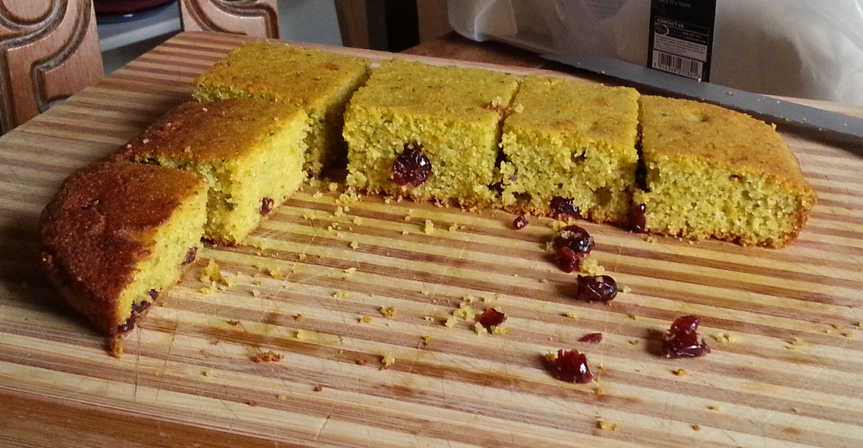
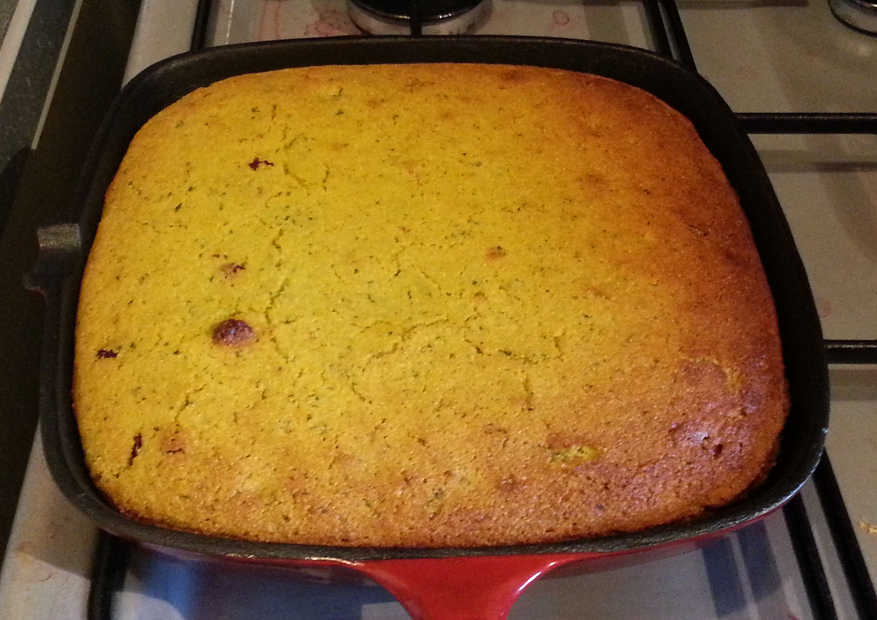
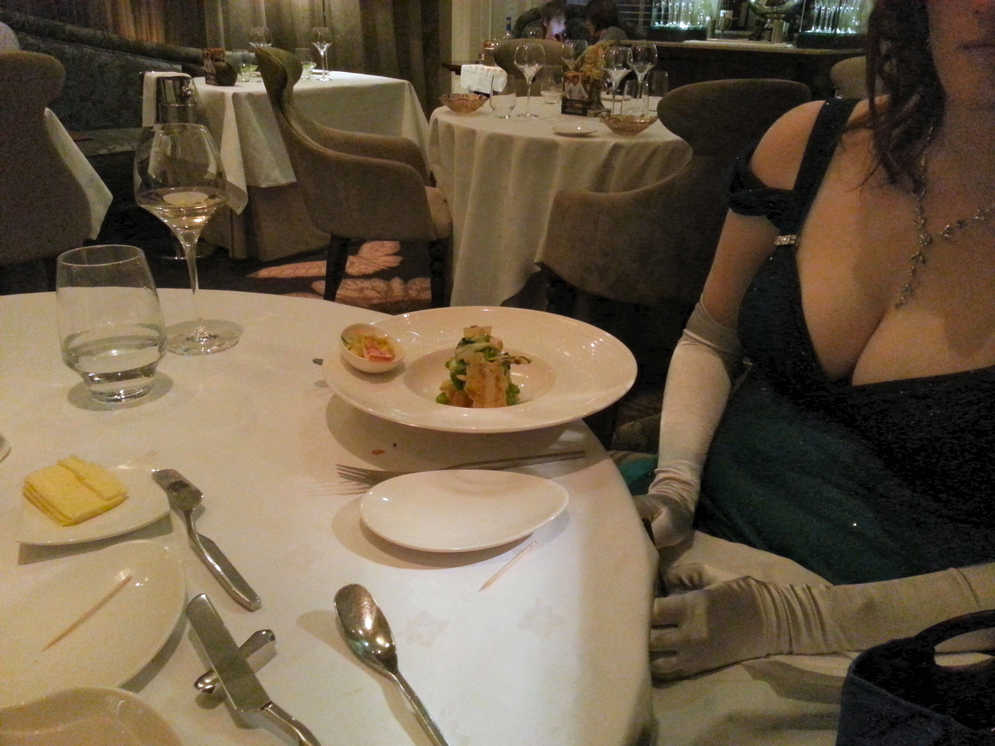

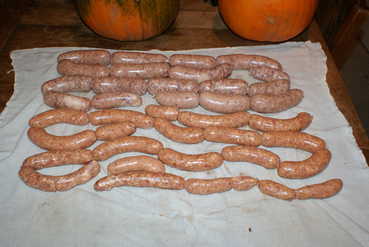

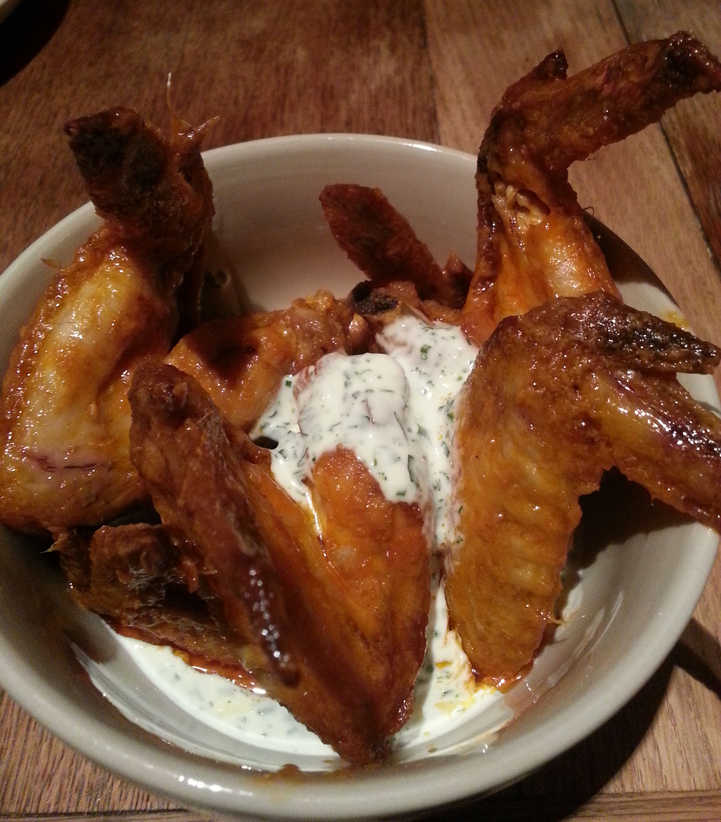
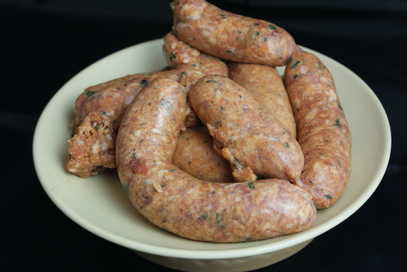
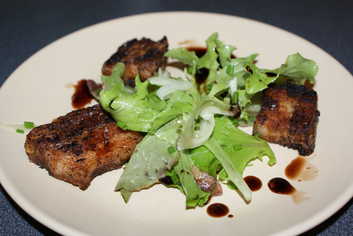
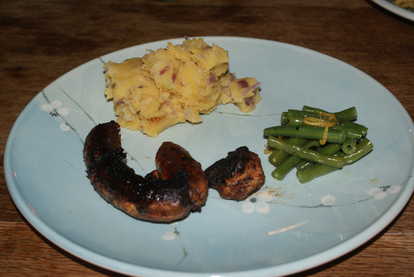
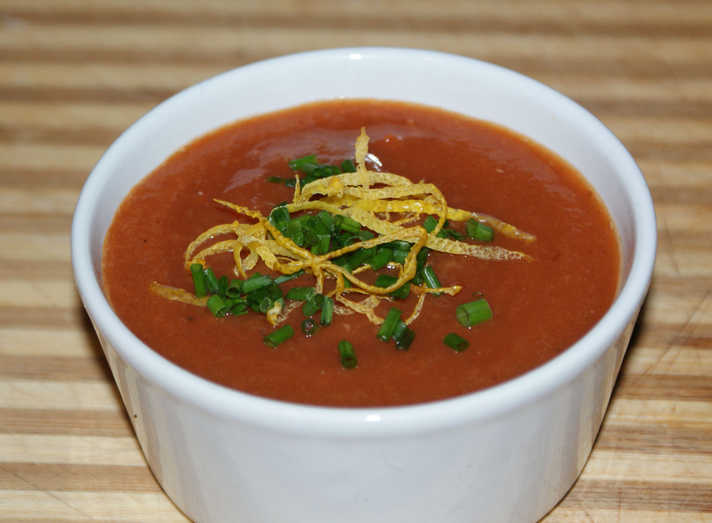
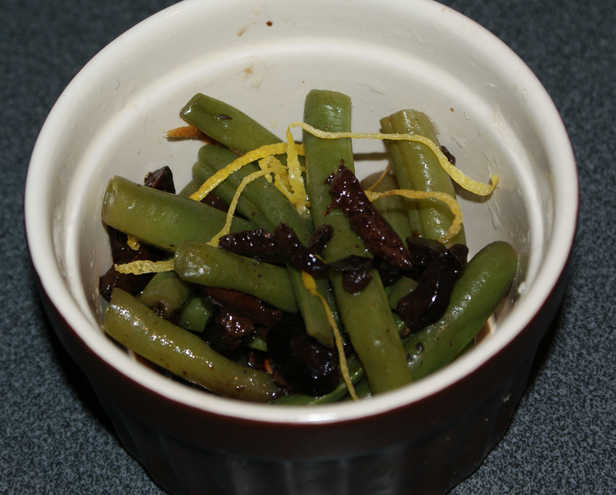
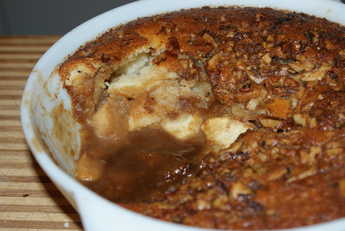
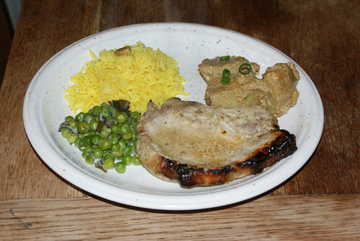
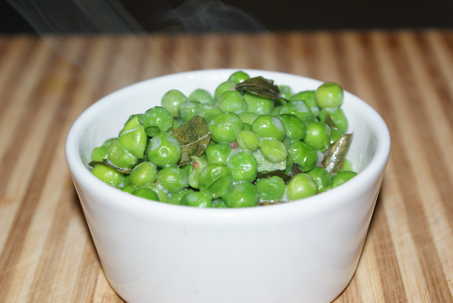
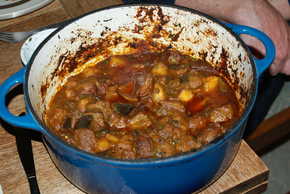
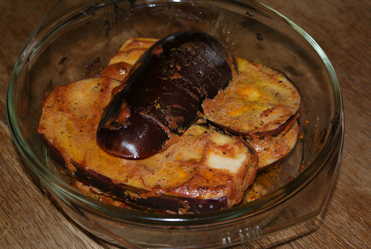
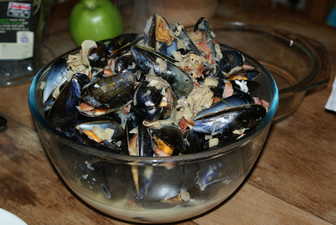
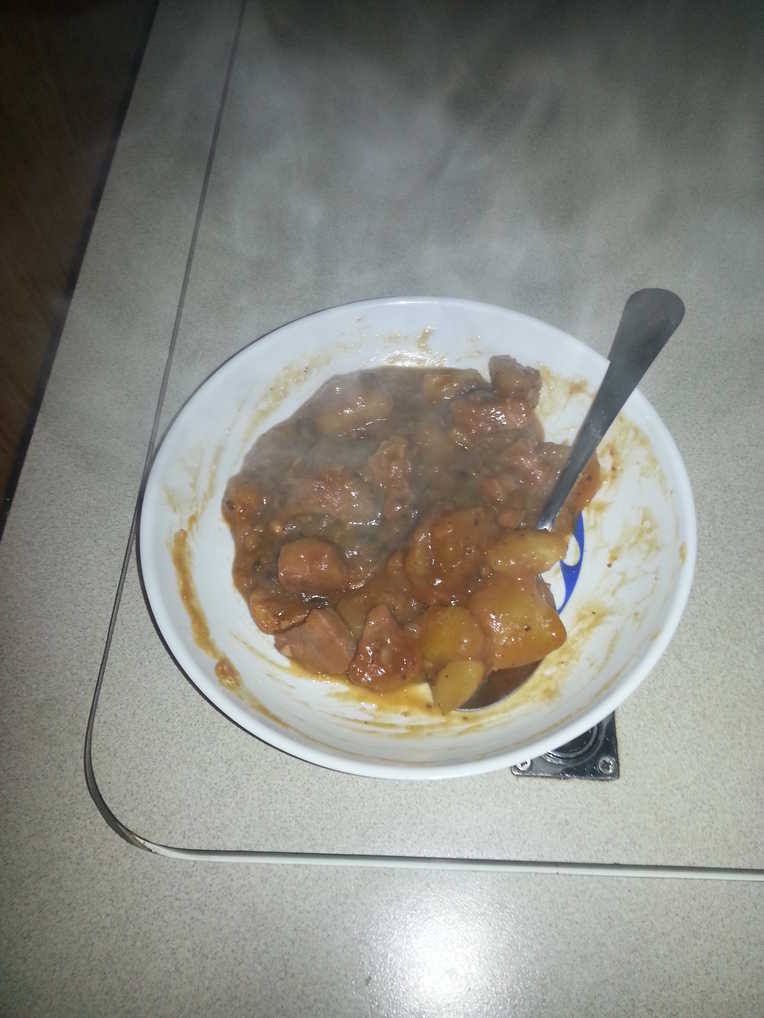
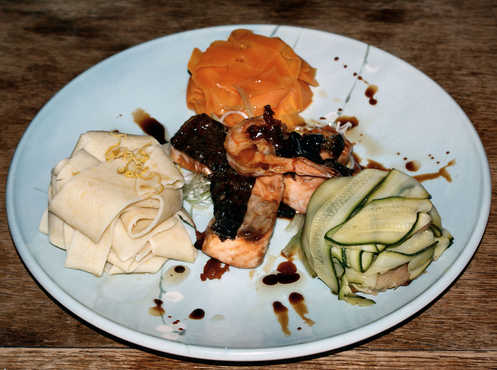
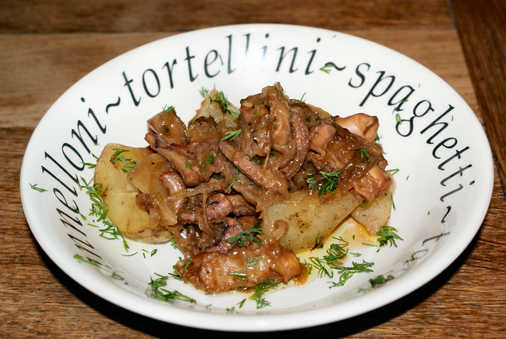
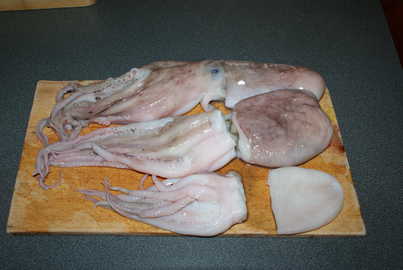
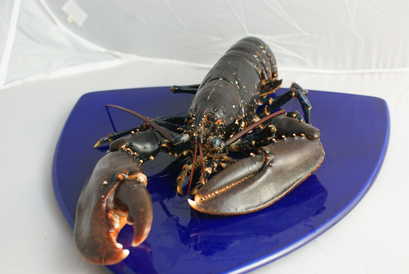
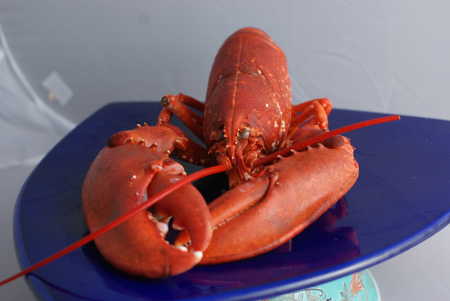
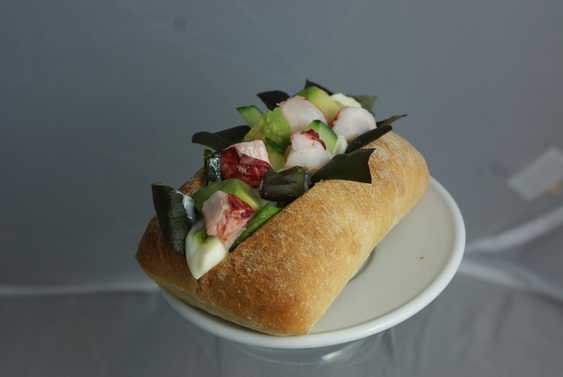
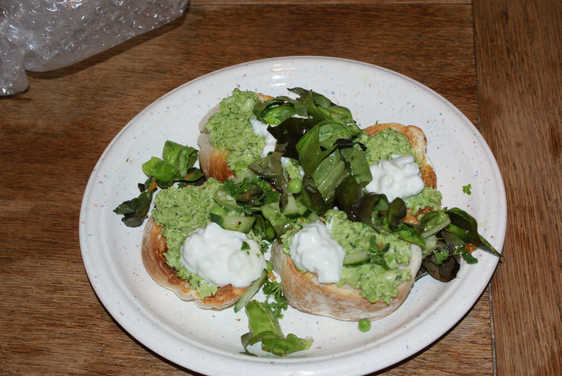
I used 4 jalapeño peppers, and the bread had quite a bit of kick. You should probably use less if your guests are heat sensitive.
I wasn't sure whether the coriander would work, but it does actually.